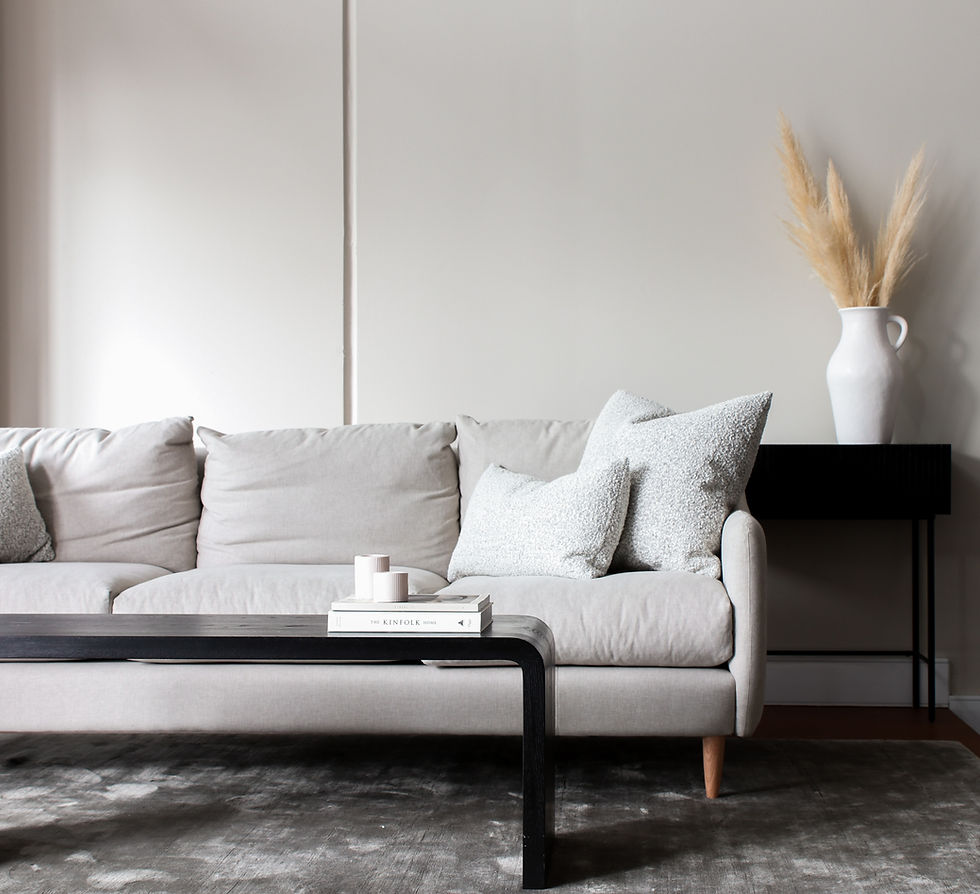7 Interior Designing Tips For Better Mental Health & Wellbeing
- AMY

- Mar 23, 2022
- 5 min read
Since the pandemic, we have spent most of the last couple of years trapped within our homes. The soaring fame of remote work opportunities confined us to our personal spaces even when the government relaxed social restrictions. But imagine having to work 8 hours a day in your dark, cluttered, and lacklustre home office, and in your PJ's. Good-bye productivity!
And that is why the designers among us are now focusing more on making homes a better environment to live plus work in and be overall mentally healthy.
Tracie Weeks, MA for Rocky Mountains Forest Products, published a study about the effects of aesthetics and interiors on overall mental health. She concluded that a few simple design strategies could alter a person’s mood and mental state.
So why not make your space a bit more cheerful and incorporate our seven interior designing tips for uplifting your mental wellbeing? After all, good mental health is the way to move forward in the modern pandemic-ridden world.

How Interior Design Affects Mental Health
Our environment has an incredible effect on our minds. We sense the vibes of a space, and our mood alters accordingly. A study in the Journal of Architectural Institute of Korea used bio signals to measure the effects of interior design on a person’s emotion.
The researchers found out that a room’s form, lighting, furniture, and materials impact our emotions and mental health.
Such studies have become a turning point in modern design trends. Now, architects are incorporating psychology into their projects, and designers are using techniques for creating emotionally positive spaces. Corporate companies use layouts that boost the productivity of their employees, and health care centres focus more on a tranquil colour scheme.
But work-from-home jobs now require you to redesign your personal spaces a bit to get the most out of them. So, if you too are looking to redesign your home to make it more than just visually appealing, these seven interior tips will help you hit the right mental note.
“Your home should be your sanctuary — a place for you and your family to recharge, relax and grow.”
Interior Designing Tips For Mental Well-Being
The interior décor of our homes needs to be in line with our comfort and should feel welcoming. These 7 tips can help you achieve just that:
Minimalism
A tranquil interior design discourages clutter and promotes minimalism. Get rid of everything you don’t need or love and keep what is necessary. Bedrooms, specifically, are not a good place to follow the modern Cluttercore trend. Hoarding unnecessary things and Maximalism induces poor quality sleep and stress. So it is never a good idea to fill up every corner of your room with something.
Leave a few open spaces, empty walls, and bare floors. Try to keep your shelves light and décor pieces to a minimum if you suffer from sleeplessness. Petite furniture with light colours and thin legs promotes a sense of decluttering.

Lights
“Our surroundings affect how we feel every day and it is important that our homes fill us with a sense of peace and wellbeing.”
Most modern offices use natural lighting since it boosts productivity. Sunlight triggers hormones in our body that stimulate our mood and positivity. Staying in a dark room or hardly ever getting out in the sun can lead to depression and anxiety.
The well-being-based interior trend for 2022 is incorporating giant windows and doors with clear glass panels. You can ditch the heavy and opaque curtains and opt for lighter flowy ones.
Or perhaps, invest in mood lighting to give your home the right atmospheric feel. Put up a few lamps in the living room to cosy it up. You can even play with different lighting colours to amplify your room’s décor.

Plants
Adding natural elements is an excellent way to create spaces where you feel most at peace, comfortable, and welcomed. Indoor plants are a fantastic way of adding more green to your décor theme. They improve the oxygen levels in their surroundings and give the space calmer and more natural vibes. Eventually, being closer to human instincts automatically leads to better emotional wellbeing.
Biophilic designs reduce stress and increase our mind’s productivity. Snake plant, rubber plant, English ivy, lavender, and several succulents give a surreal look and are extremely easy to maintain.
It is also worth mentioning that when you are out to buy a house or any property, a scenic view always hikes the price of the property because of the explicit effects it has on the residents. I mean, who wouldn’t love to wake up to a stunning view?
Be it the outdoors greenery or a beautiful panorama of a busy city, having your coffee on a picturesque balcony will have a soothing effect on your mind! That is why architects now prefer broader window panels and spacious patios to provide a glimpse of the outdoors inside the homes.

Scents
Our brain uses all of our senses to feel welcomed in a place. Our sense of smell included. Keeping your home smelling good is always a great idea. Be it your home office desk or a yoga corner to meditate on, good fragrances can instantly make you feel revitalised.
Lavender, jasmine, rosemary, vanilla, lemon, and cinnamon are all calming fragrances widely used in aromatherapy. So, you can look for these aromas in scented candles or diffuser oils to help you unwind.
There are many options available to diffuse a scent all-around your house. You can opt for electric or reed diffusers, room sprays, scented candles, oils, or flowers.

Colour
It is no secret that each colour impacts our minds differently. That is why Dulux appointed Dr. Alex George, a mental health expert, as its Colour of The Year Ambassador for 2022.
Different colour palettes affect our moods and behaviours differently. For instance, warm colours like red, orange, and yellow evoke higher emotions like love, passion, and anger. On the contrary, a cooler blue, green, and purple are symbols of peace, serenity, and sadness.
Similarly, muted shades like grey and beige keep the background neutral so you can play with your room's furniture and other accessories. Plus, they contribute to a relaxed, calming environment.
If you are looking to redecorate your home, it is good to get professional help. A talented interior designer will use various colour combinations in a suitable balance to create an uplifting and optimistic environment. The right hue and saturation can bring out the right zen vibes in your home.
Take this room here, for instance. Before an expert’s touch it lacked that bit of panache. With incredibly coordinated shades and patterns plus the necessary decadence, the designer was able to turn the place into somewhere you actually look forward to spending time at..

Art
Not only does a good art piece look fascinating, but it can also boost your energies when you look at it. Surrounding yourself with beauty will have a positive impact on your emotional state.
Adorn your walls with pretty paintings, pottery, decoration pieces, and souvenirs to fall back in love with your home. The correct details will be a way to show off your artisan taste of things and will always make you feel amazing about yourself.

Style
Revamp your room, get a new couch, and put up new curtains. A touch of style and luxury will help you feel upbeat while you're at home.
An old, monotonous interior will always leave you yearning for more. A professional designer can help you in this regard by selecting the most trending pieces and themes that could go with your setting and requirements.

Conclusion
A decluttered room with ample lighting, indoor planters, cheerful colour scheme, decadent details is vital for creating a comfortable personal space. They trigger our brain to release happy hormones in our bodies and help in relaxing and revitalising.
So, whenever you plan on revamping your house look, make sure to use our seven effective interior designing tricks for better mental health.





Comments